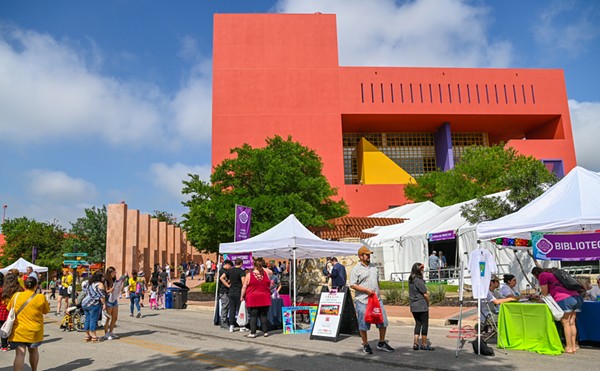But Lifshutz’s delayed multi-use development along the southern extension of the San Antonio River proves once again the intangibility of their happiness.
Plans for Big Tex, aka the former Texas Vermiculite/W.R. Grace plant, have swirled in place like twigs in the coffee-brown waters beneath it, held up most recently by state and federal regulatory processes meant to determine whether the soil and buildings are extensively contaminated with leftover amphibole asbestos, a poisonous mineral contained in the more than 100,000 tons of raw vermiculite ore that came to San Antonio via Southern Pacific rail from Libby, Montana `“Nixing Big Tex,” May 12, 2005; “Developing environmental oversight,” May 3, 2006`.
Delays can also be attributed to the developer and some good lawyering, said Eric Delgado, the Environmental Protection Agency’s Big Tex on-scene coordinator, adding that his office is typically involved in projects for no more than a year — “We get in and get out.” But Lifshutz has been getting his money’s worth out of SA law firm Richie & Gueringer, says Delgado.
Documents obtained by the Current show that Liftshutz’s legal eagles continue to rail against the EPA’s “puzzling” stances on concerns and procedures for asbestos sampling and public safety.
“You raise the issue of tenancies and First Fridays,” writes Gay Gueringer to EPA’s senior attorney Gloria Moran on May 17. “Big Tex previously elected to remove all of its tenants from the Property `“Big Tex moving day,” March 28`. This despite the EPA’s refusal to inform Big Tex whether the removal of the tenants was required for their safety. The question of the tenants’ safety was one raised by Big Tex many times over many months. The EPA avoided responding and at best indicated it would ‘get back to us.’ An answer never came … Big Tex acted voluntarily to remove its tenants. If Big Tex had waited for the EPA to respond to its request on whether the tenants were at risk, it would still be waiting and the tenants would still be on the Property.”
It would make your head pop to review all their points poking holes in the EPA’s rationale for requiring certain procedures without certain precautions and conclusive findings. Also, the firm wanted to know why the hell the EPA didn’t notify them or their client that Big Tex was being designated a Superfund site until February 2007.
The EPA told the Current it’s an issue of semantics — that the Big Tex property has not been listed on the Superfund National Priority List for abandoned toxic waste sites. The EPA said the new moniker is due to the EPA division and funding source for federal investigations into Big Tex, which both come under the Superfund program. Superfund law lets the agency collect millions of dollars in fees from polluters to clean up sites, a practice initiated after the high-profile ’70s “public-health time bomb” known as Love Canal.
Possibly inspired by being pinned with the nation’s superlative toxic term, the developer decided to pursue a new track for remediation. By June 11 Lifshutz submitted an application to enter the property into the state’s Voluntary Cleanup Program, which releases the landowner of future liability should this Libby site cleanup later be deemed insufficient. According to the EPA’s Delgado, it’s the first Libby site to be considered for such a program.
The VCP application included a $1,000 fee and an overdue site-specific sampling plan previously requested by the EPA (Lifshutz failed to provide an adequate sampling proposal by a May 18 due date, according to EPA correspondence obtained by the Current). This plan, put together by an environmental cleanup consultant — TGE Resources out of Houston — is a blueprint for what is expected to be the most extensive sampling activities the site has received to date: In the past seven years, there’ve only been “limited investigations,” according to EPA documents. Which means no final determinations about what needs cleaning — or encasing and capping in cement — at Big Tex have been made yet, just the same old health-and-safety questions related to stirring up the dirt and potentially releasing asbestos fibers into the air.
By mid-July, Lifshutz should hear whether Big Tex has been accepted into the VCP, overseen by the Texas Commission on Environmental Quality and closely monitored by the federal environmental agency, with whom he’s still expected to keep working on a parallel track for soil analysis and a remediation work plan. The EPA’s national expert on Libby sites, Brian Brass out of the Nevada office, sat in on the June meetings with TCEQ and TGE, the developer’s environmental consultant.
In the meantime, the Current has kept an eye on the property ever since a chain-link fence around Big Tex’s perimeter went up in April. The gate was open (“It’s supposed to be padlocked,” Delgado said), and inviting to a trespasser on one of those brilliantly hot, cloud-free April days.
Inside the gate a few yards, the trespasser encountered a busy landscaper covered in grass chips and potentially hazardous dirt. He worked his chattering weed whacker behind a mound of earth, across from the recently vacated art silos, which is weird, considering that every EPA official insists the property is too hazardous for any soil-disturbing activity, and there are EPA signs warning “Stop!” and “Paro!” that should discourage even a casual traipse.
The landscaper, who identified himself only as Juan and 32-years-old, said the jefe never mentioned that the area was considered contaminated. After he was shown a posted warning sign and it was explained to him in halting Spanish that hay algo peligroso en la tierra, algo malo para su pecho, he said he’d been weed-whacking out there for eight hours already, and that he’d take it up with Lifshutz’s property management. Lifshutz’s management office said they would not comment on Big Tex and he’s out of town through mid-July.
All this to say it’s slow going over there. There’s miscommunication, as former Councilwoman Patti Radle gently puts it. And the Big Tex development seems a long way from becoming a four-story apartment complex above the river’s west bank. It’s a long way from being a complement to the nearby scenic Southern River Reach, to the First Friday art walk, to the open-air bars that seem as close as a well-stocked ice chest at your feet. It could all be so beautiful.
















